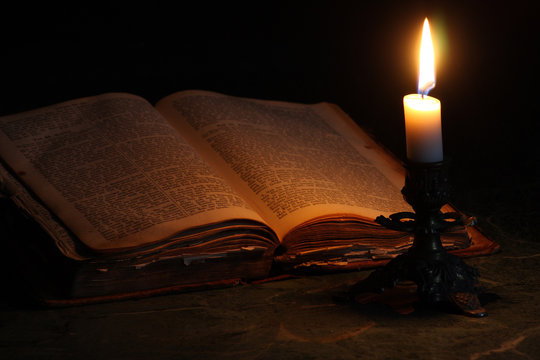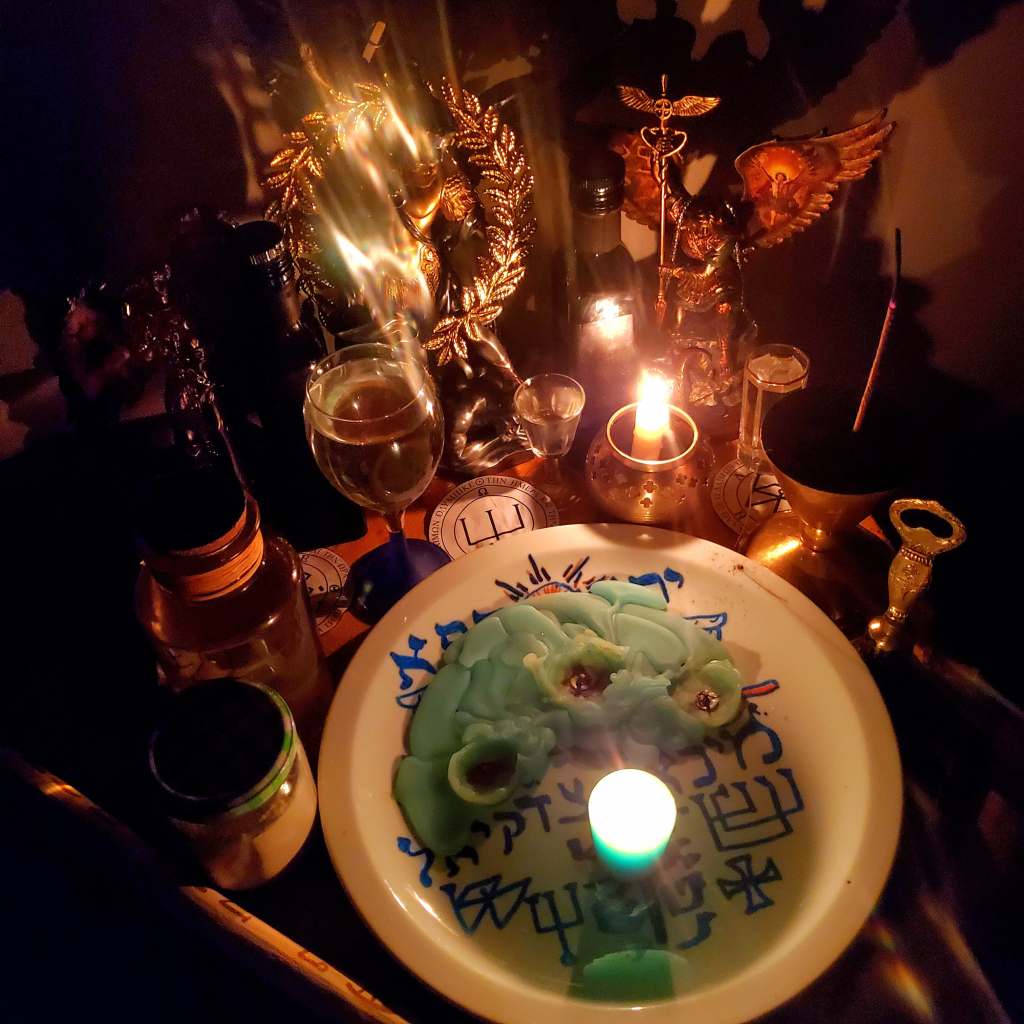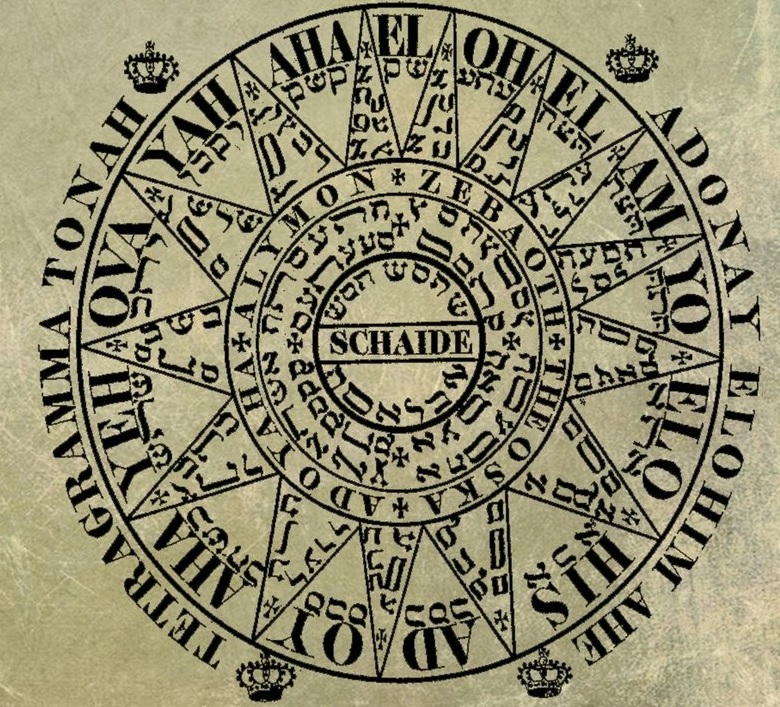By Adam J. Pearson (2024)

A.1. Introduction: Unveiling The Mind(s) Behind the Doctrine of Mind
Published in 1908, The Kybalion: Hermetic Philosophy by the anonymous “Three Initiates” is undeniably one of the most famous and influential occult texts of all time. This holds true to the chagrin of many occultists who have rightfully questioned its invented frame narrative, divergences from classical Hermeticism, and spurious roots in an imaginary ancient text (Block, 2019; Chapel, 2013; Farrell, 2014). To this point, with his characteristic wit and humor, Sam Block (2019) went so far as to claim that “The Kybalion is a farcical waste of ink, paper, and time, and is not representative of Hermetic philosophy, instead being a work of New Thought dressed up in Egyptomaniacal cosplay. There’s literally everything else better to read than The Kybalion.”
As we shall see, the present study largely agrees with the substance of these critiques. In all fairness to The Kybalion’s faux-legendary origins, however, the legacy of Medieval and Renaissance grimoires attests to the fact that the tendency to attribute fictional origins to esoteric texts is so commonplace in the history of magic as to virtually be a staple of the genre. To offer some well-known examples of this trend, we note, for instance, that the Clavicula Salomonis was attributed to King Solomon, the Grimoire of Pope Honorius to the historical Pope, the Tuba Veneris to John Dee, The Heptameron to Peter d’Abano, and the Sixth and Seventh Books of Moses and Sword of Moses to the biblical Moses despite these figures having nothing to do with their composition (Bailey, 2009; Bailey, 2017; “Dee,” 2001; Pearson, 2018; Peterson, 2005; Peterson, 2018; Skinner, 2013; Stratton-Kent, 2014). The authorial intent behind this fabrication of textual origins was likely to add authoritative weight and prestige to the grimoires so that they would be taken more seriously by the reader. Just as a “master’s guide to boxing” would tend to be taken more seriously if it was attributed to Muhammad Ali rather than revealed to be written by Bob from the local gym, such was the case for the grimoires.
Interestingly, it is worth noting that The Kybalion‘s New Thought-influenced system exerted some surprising influence even on key figures in the 21st century traditional grimoire magic movement. In a striking example, Wolfe, one of the few students of the late Dr. Joseph Lisiewski, explained that after guiding his students through intensive grimoire evocations carried out by-the-book to the finest details, as well as alchemy and other studies, Dr. Lisiewksi ended up teaching them New Thought techniques (WOF 25, 2021). Since Dr. Lisiewski was also a notoriously vociferous critic of New Age practices, this revelation was shocking to this author, but also suggested the prospect that closer investigation of The Kybalion’s New Thought origins might be worthwhile even to grimoire purists.
On a personal note, The Kybalion holds a certain charming nostalgia for this author as it was one of the first esoteric texts he read as green-horned adolescent. Despite rapidly moving on from the text to explore more traditional materials, the feeling of intrigue first felt when presented with the mysterious anonymity of the “Three Initiates” continued to linger over the following decades. The present study is, in some ways, an informed adult response to that naive teenage curiosity.
For those who may be unfamiliar with the text, The Kybalion presents, in its own words, a series of “seven Hermetic principles,” upon which it claims that “the entire Hermetic philosophy is based,” namely:
1. The Principle of Mentalism
“The All is Mind; the Universe is Mental” (“Three Initiates” in Deslippe, 2011).
2. The Principle of Correspondence
“As above, so below; as below, so above.” […] This principle embodies the truth that there is always a correspondence between the laws and phenomena of the various planes of being and life (“Three Initiates” in Deslippe, 2011).
3. The Principle of Vibration
“Nothing rests; everything moves; everything vibrates” (“Three Initiates” in Deslippe, 2011).
4. The Principle of Polarity
“Everything is dual; everything has poles; everything has its pair of opposites; like and unlike are the same; opposites are identical in nature, but different in degree; extremes meet; all truths are but half-truths; all paradoxes may be reconciled” (“Three Initiates” in Deslippe, 2011).
5. The Principle of Rhythm
“Everything flows, out and in; everything has its tides; all things rise and fall; the pendulum-swing manifests in everything; the measure of the swing to the right is the measure of the swing to the left; rhythm compensates” (“Three Initiates” in Deslippe, 2011).
6. The Principle of Cause and Effect
“Every cause has its effect; every effect has its cause; everything happens according to law; chance is but a name for law not recognized; there are many planes of causation, but nothing escapes the law” (“Three Initiates” in Deslippe, 2011).
7. The Principle of Gender
“Gender is in everything; everything has its masculine and feminine principles; gender manifests on all planes” (“Three Initiates” in Deslippe, 2011).

In the present study, we will begin by analyzing The Kybalion’s claims to be of ancient Hermetic origin transmitted by the “Three Initiates.” We will then proceed to critically analyze the evidence for and against the 12 primary candidates that have been proposed as having been members of the enigmatic “Three Initiates” over the past 116 years.
To this end, while we will respectfully explore traditions shared among occultists, we will predominantly adopt a critical-historical methodological lens. More specifically, in order to evaluate the authorial feasibility of these 12 candidates as rigorously as possible, we will draw on the comprehensive analytical work of Professor Philip Deslippe (2011) and on the historical context of these 12 individuals as well as their geographical, textual, creative, biographical, and authorial circumstances during the period of The Kybalion’s composition.
The aim of this study is to complement the extensive and valuable work done by Deslippe (2011) and others with additional evidence and insights from later publications in order to arrive at an integrative overview of the subject of Kybalion authorship as presently understood in 2024. Before we meet these mysterious 12 candidates, however, let us briefly investigate The Kybalion‘s claims to ancient roots.
A.2. Is The Kybalion Ancient and Hermetic?: Critically Evaluating The Kybalion’s Self-Claimed Origins
In the Introduction to The Kybalion, the “Three Initiates” claim that the text represents “a work based upon the world-old Hermetic Teachings” which they suggest lie hidden behind all noteworthy ancient philosophies from those of Egypt to the Vedic teachings of India (Deslippe, 2011). To this point, The Kybalion claims that “even the most ancient teachings of India undoubtedly have their roots in the original Hermetic Teachings.” Unfortunately for The Kybalion, there is no evidence that the Hermetic teachings that emerged in the first centuries of the Common Era influenced the development of ancient Indian Vedic thought; indeed, the simple fact of historical chronology makes this impossible since the Vedas were written from 1500 to 500 C.E., long before the first Hermetic texts (Bull, 2015; Ghosh & Ghosh, 2020; Levitt, 2003; Lopez, 2020; Тошов, 2021).
The “Three Initiates” go on to suggest that they are presenting “a compilation of certain Basic Hermetic Doctrines, passed on from teacher to student” that have their roots in an ancient book called The Kybalion, which they claim to be quoting and commenting on in their own work (Deslippe, 2011). We now know that there is no evidence that the proposed “ancient book” which the Three Initiates are quoting ever existed. Indeed, it could not have existed in the form The Kybalion presents because, for instance, as Chapel (2013) notes, the “Principle of Vibration which the aphorisms so heavily emphasize, […] originated in the middle of the 18th century with the British philosopher and medical doctor David Hartley (1705-1757). The commentary on the aphorisms is decidedly of 20th century provenance, referring as it does to works that were not published until the early 1900s” (see also Oberg, 1976).
To be charitable, those who favour “ancient and Hermetic origins” of the principles expounded in The Kybalion point out that some aspects of The Kybalion’s doctrine appear to resonate with ideas in the Corpus Hermeticum (1st-3rd c. CE) and Asclepius 4, such as the idea that the Universe arose from the Divine Mind. Others have claimed that the Principle of Correspondence as having roots in the Tabula Smaragdina or Emerald Tablet of Hermes Trismegistus as well as that the word “Kybalion” appears in a French Masonic Memphis-Misraim Rite that allegedly predated the publication of The Kybalion (Mead, 2015; Copenhaver, 1993). We will critically return to this latter point. However, for reasons we will explore in greater depth below in Section H, it seems more likely that The Kybalion integrated inspiration from Hermetic tradition as interpreted by three 19th century works into a mostly New Thought-based framework, rather than chronicling an oral tradition transmitted in unbroken lineage “from Adept to Adept” (Block, 2021; Chapel, 2013; Deslippe, 2011; Dresser, 1919; Farrell, 2014).
In support of this view, Chapel (2013) undertook a thorough comparative analysis between The Kybalion and classical Hermetic texts as well as the corpus of 19th-century New Thought literature and found very little “Hermetic” content in The Kybalion, a point with which Sam Block’s (2019) own analysis of the non-Hermetic elements of The Kybalion agrees. Chapel (2013) suggests that some possibly “Hermetic” aspects of the text could include its Correspondence Principle of “as above, so below,” its Divine Mind-based idealism, and some aspects of its “Principle of Gender” (e.g. Asclepius, 21: “Not only god [is of both sexes]…but all things ensouled and soulless, for it is impossible for any of the things that are to be infertile”) (c.f. Copenhaver, 1993).
To counterbalance this point, however, Chapel (2013) also notes that The Kybalion‘s rather idiosyncratic 147-plane cosmology has nothing to do with classical or Renaissance Hermeticism, nor does its focus on “mental alchemy” of the personal mind rather than Mind (Nous), its lack of emphasis on piety towards an emanative Godhead, its exclusion of the practice of ecstatic absorption [ebaptisanto tou noos] in the Divine Reality, or its anti-theological stance which runs counter to the mystical theology of classical Hermeticism (Chapel, 2013).
Complementing Chapel’s (2013) observations, Sam Block (2021) points out that in classical Hermeticism, the Divine was generally viewed as androgynous or transcending gender (e.g. in Corpus Hermeticum I.9: “The Mind who is god, being androgyne and existing as life and light…”). Indeed in the Corpus Hermeticum, gender only enters into play following an androgynous Age described in 1.18 after which the Godhead splits the previously-androgynous human life into male- and female-gendered beings (Block, 2021). To buttress Chapel’s point about ancient theology (2013), Erik (2016) underscores the significant theological differences between The Kybalion and classical Hermeticism by contrasting The Kybalion‘s anti-theological, pantheistic and unknowable All with the heavily theological classical Hermetic view in which, in Erik’s (2016) words, “full knowledge of God is the ultimate goal of the Initiate.”
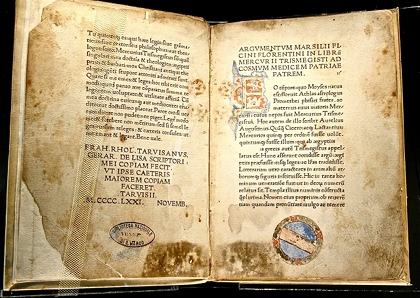
Moreover, against the claim that the term “Kybalion” has its roots in the Irregular Freemasonic Memphis-Misraim Rite as noted above, Rob Wood (1997) has demonstrated that the word ”Kybalion’‘ was, in fact, interpolated into the Memphis-Misraim Rite after the publication of the 1908 Kybalion. He found 19th century manuscripts of the same rituals–that is, manuscripts earlier than the earliest manuscript of The Kybalion–which did not include the word. This shows that “Kybalion” was added in to the Rite later, likely to draw on the mystique introduced by the Three Initiates’ text. In addition, Wood (1997) observed that the ”Founder of the Rite of Memphis, Marconis de Negre, did not know the term “kybalion,” nor did the Italian General Garibaldi and International Hierophant of Memphis-Mizraim — he united the two rites. The same holds for Seymour, Yarker, Papus, etc.”
Far from being ancient, The Kybalion is incontrovertibly modern, dating to the 20th century after being published in 1908 and written in 1907 in Chicago, as Deslippe (2011) demonstrated through the careful analysis of archival documents. Moreover, as Deslippe (2011) notes, The Kybalion was very much the product of its times as a text that emerged, not from the Ancient Graeco-Egyptian world, but rather from the industrialized, mechanized, capitalistic, and achievement-oriented world of 20th century America that was looking for a secularized, New Age philosophy to fit with its ideals of “manifesting” success (Deslippe, 2011). Indeed, as we noted above, and as Chapel (2013) notes, the “Three Initiates” reference 18th century and 20th century texts that were unknown to ancient authors. The Kybalion’s early 20th-century origins are further evidenced by a number of features of the text, which Deslippe analyzes in detail in his Introduction to The Kybalion: The Definitive Edition (2011), but most conspicuously in The Kybalion‘s frequent references to then-current pseudo-scientific ideas to illustrate its “Principles,” its anti-theological stance, and its New Thought style and approach. As aptly Sam Block (2021) aptly noted, “The Kybalion isn’t so much a rewrite of Hermetic philosophy and ideas into modern language, as it is an injection of New Thought ideas into Hermeticism.”

Furthermore, to buttress the modern origins of the text, Mary K. Greer (2009) found “a major source of The Kybalion’s 7 Laws in an introduction to a translation of Hermetic writings by Anna Kingsford and Edward Maitland called The Virgin of the World of Hermes Mercurius Trismegistus (1885),” with which the “Three Initiates” would have been very familiar as we shall see below. Indeed, Greer (2009) discovered that ”in the short introductory essay to The Virgin of the World (1885), called “The Hermetic System and the Significance of its Present Revival,” we find nearly the same seven (unnumbered) laws, doctrines or principles that are found in The Kybalion.” We now know that the ideas in The Kybalion predominantly originated not only in Maitland and Kingsford’s work, but also in two other 19th century texts by Thomas Burgoyne and Florence Huntley, a fascinating point to which we will return in Section H of this study.
The Kybalion then, seems, to be as charitable as possible to the text, to be a 20th century New Thought reformulation of 19th-century recapitulations of some earlier Hermetic ideas combined with 18th ideas from Hartley and others (e.g. the Principle of Vibration). If The Kybalion contains “Hermetic” content then, this might largely be credited to the research of Kingsford and Maitland, Burgoyne, and Huntley which the “Three Initiates” reinterpreted via New Thought to create the 1908 text.
A.3. The Question of Authorship: Who were the “Three Initiates”?
Regardless of its modern origins and its Hermeticized New Thought teachings or New Thought-ized “Hermetics,” the intriguing anonymity of the mysterious author(s) of The Kybalion has played a significant role in contributing to its enduring appeal. Who, then, were the “Three Initiates” to whom The Kybalion was legendarily attributed?
In the sections to follow, we will delve into the complex bouillabaisse of historical fact, precise findings yielded by software-driven textual analysis, oral traditions passed between occultists, and far-ranging speculations that have accrued around the secret identities of the “Three Initiates” over the course of the past 116 years. In the process, we will attempt to draw back the veil of mystery that surrounds the text’s authorship, unveil the identity of its core author, dispel common theories about some alleged contributors to The Kybalion, and explore some surprising influences on the text. In total, we will consider the cases for and against 12 different candidates, but our story begins with a man named William Walker Atkinson (1862 – 1932).
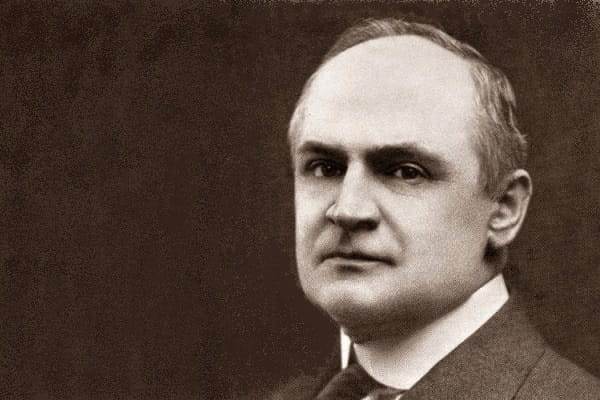
B. The New Thought Initiate: William Walker Atkinson (1862 – 1932), the Lawyerly Law-Giver
Who was the primary mind behind The Kybalion? For years, the “First Initiate’s” identity was hidden in secrecy, misdirection, and false assumptions. However, a major breakthrough in the process of unmasking his identity came in 2011, when Philip Deslippe, Professor of Religious Studies and Historian at U.C. Santa Barbara, ran The Kybalion (1908) and all of William Walker Atkinson’s books through plagiarism-detection software and the analysis concluded, based on objective textual, lexical, and syntactic features, that they were definitively written by the same person (Deslippe, 2011). This ground-breaking research, which applied contemporary digital analytic tools to the study of occult authorship, confirmed beyond all doubt what whispers from occultists had only been able to suggest for decades. See Deslippe’s episode on Forum Borealis in October 2018 for more insight into how he conducted his computer-mediated textual analysis using software at the University of Iowa.
As a result of this research, Deslippe (2011) decisively identified the primary author of The Kybalion as the attorney, merchant, publisher, author, and occultist William Walker Atkinson (1862 – 1932), who was also an American pioneer of the New Thought movement. Indeed, The Kybalion is, in (a) its New Thought-influenced content, (b) its lists of laws so beloved to its attorney author, (c) its diction, lexicon, syntax, and turns of phrase, (d) the circumstances of its production in Chicago in 1907, and (e) its publishing house, definitively the primary production of William Walker Atkinson (Deslippe, 2011).
By way of context, Atkinson was a tremendously prolific author who wrote over 100 books in his lifetime, many, like Kybalion (1908), under pseudonyms as far-ranging as Theron Q. Dumont, Swami Panchadisci, Theodore Sheldon, Magus Incognito, and Yogi Ramacharaka (“Three Initiates” in Deslippe, 2011). As Deslippe (2011) notes, all of the supposedly independent authors whose writings are now credited to Atkinson were connected to one another both (a) by their textual features (e.g. word choice, syntax, particular turns of phrase used across texts, etc.) and (b) by being published by houses with shared addresses and (c) in the same magazines. William Walker Atkinson edited all of the magazines in which his pseudonymous authors’ writings appeared, namely, Suggestion (1900–1901), New Thought (1901–1905) and Advanced Thought (1906–1916). These fictional authors first acted as contributors to the periodicals, before diverging into their own book-writing careers—with most of their books being released by publishing houses for which Atkinson worked. This process enabled a cycle of prestige-building for both the magazines and the books; the magazines attracted attention to the pseudonymous authors and Atkinson used “their” books to add credibility to the magazines.
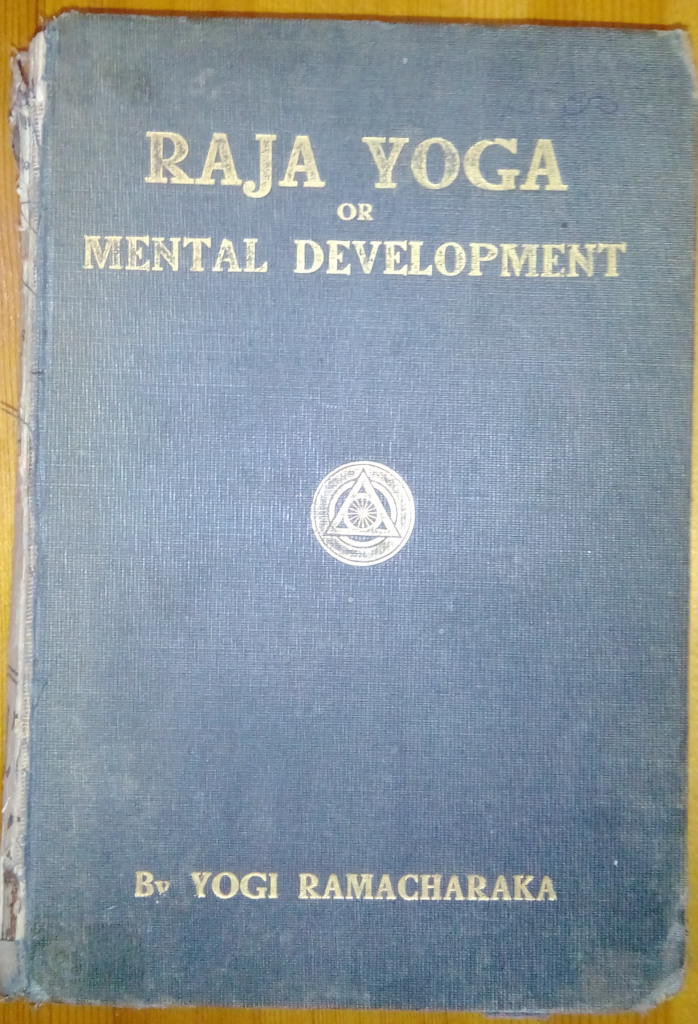
For example, Deslippe (2011) notes that Advanced Thought magazine, which was edited by Atkinson, advertised articles by Atkinson and Theron Q. Dumont and had the same address as The Yogi Publishing Society, which published the works attributed to Yogi Ramacharaka. Advanced Thought magazine also printed articles by Swami Bhakta Vishita, but when Vishita’s writings were collected in book form, they were not published by the Yogi Publishing Society. Instead they were published by The Advanced Thought Publishing Co., the same house that released the Theron Q. Dumont books and published Advanced Thought (“Three Initiates” in Deslippe, 2011). By crafting different authorial personas and attributing diverse works to them, Atkinson was essentially able to become a roster of multiple pseudonymous authors and ensure a steady stream of content for his periodicals.
Thus, well-practiced in the Kierkegaardian Art of Pseudonymity, Atkinson went on to create the “Three Initiates” as an authorial screen for his writing of The Kybalion. The Kybalion allowed Atkinson to promote his New Thought ideas while capitalizing on the resurgence of popular interest in Hermeticism in 1907-1908 Chicago through the work of groups like W.P. and Myra Phelon’s Hermetic Brotherhood of Atlantis, Luxor, and Elephantae (see Section H for more on this subject).
Deslippe (2011) further notes that after The Kybalion‘s publication, Atkinson proceeded to revise and rework the framework of the Seven Hermetic Principles which he laid out in The Kybalion in a series of succeeding works via the Seven Laws in his 1909 Arcane Teaching, the Seven Cosmic Principles in his 1918 Secret Doctrine of the Rosicrucians, and The Seven Cosmic Laws in his final work on the subject, The Seven Cosmic Laws, which remained unpublished in Atkinson’s life until its posthumous publication in Deslippe’s Kybalion: The Definitive Edition (2011). The manuscript of The Seven Cosmic Laws was bequeathed to Deslippe by some descendants of William Walker Atkinson himself, who found the text in his estate after the prolific author passed away following complications from a stroke in 1932.
The Kybalion is, therefore, in every way, the brainchild of the mind of William Walker Atkinson, in form, subject matter, style, and structure. Sealing the matter, in 1912, Atkinson himself submitted a biographical entry about himself to the 1912 edition of Who’s Who in America in which he listed The Kybalion as one of his works (Nelson Marquis (Ed.), 1912). It is notable that Atkinson did not include any other co-authors alongside himself for members of the “Three Initiates” in the Who’s Who in America entry.
The case is, therefore, closed for the primary “Initiate” behind The Kybalion. Were there really Second and Third Initiates at all, or was the text simply the work of Atkinson as Deslippe (2011) suspects? To further explore this mystery, let us delve into and critically evaluate the leading theories behind 11 other possible contributors to The Kybalion in light of historical and textural evidence.

C. A Second Initiate?: The Case For and Against Paul Foster Case
Before Deslippe’s software-guided analysis definitively settled the matter, a longstanding theory in the occult community had held that The Kybalion (1908) was co-authored by Golden Dawn Initiate and Builders of the Adytum (BOTA)-founder Paul Foster Case (October 3, 1884 – March 2, 1954).
To this point, Frater R.C. of the Magick Without Fears Podcast reported that Paul Foster Case’s student Arisa Victor told him that Case had told her that he helped William Walker Atkinson with The Kybalion. Moreover, the proponents of the theory that Case was one of the Three Initiates refer to some additional points to connect Case to Atkinson. These authors note that Case was a relative of Atkinson’s wife Margaret Foster Black (1871-1950), was in Chicago in 1907 when Atkinson was writing The Kybalion, and was allegedly spending time with Atkinson around this time (e.g. see Clark, 2013).
In his biography of Paul Foster Case, Dr. Paul Clark (2013) claims that after reading William Walker Atkinson’s The Secret of Mental Magic (published in January, 1907), Case contacted Atkinson. Case had been writing articles for the New Thought magazine for which Atkinson also wrote in 1907-1908 and they likely would have met at one of the publisher-hosted author receptions. As possible evidence of the latter point, Deslippe (2011) unearthed an advertisement from the March 1910 issue of New Thought magazine for one such event: an opening reception hosted by publisher The Library Shelf, which both Case and Atkinson probably attended. Moreover, Clark (2013) states that Case’s successor Ann Davies informed him that Paul Foster Case told her that he worked on The Kybalion with Atkinson and and that Case’s widow Harriet Bullock had independently confirmed the same point to him. Thus, a total of three BOTA-related individuals have claimed Case told them he worked on The Kybalion, namely, Arisa Victor, Harriet Bullock, and Ann Davies.
Moreover, Clark (2013) claims that he found an entry in Paul Foster Case’s personal diaries, which detailed “Atkinson and Case’s decision” to name the book ”The Kybalion” as a synthesis of the words ”Kabbalah” and the Divine Name ”On.” Unfortunately, however, Mr. Clark did not include a scanned copy of this possibly very pivotal entry in the book, so there is no way to verify this claim or prove that the entry dated before the publication of The Kybalion and not afterwards. In any case, Chapel (2013) points out that although “kybalion” takes the form of a Greek noun, it has no meaning in Greek or any other language for that matter, a fact which buttresses the claim that it is a 20th century neologism. There are also no explicit elements of Hebrew Kabbalah or Hermetic Qabalah in the text. As an Adept of the Alpha et Omega Order of the Golden Dawn under Chief Moina Mathers, Case was well-versed in the Kabbalah; it is hard to see why he would call a text ‘Kabbalah-On’ and yet include no Kabbalistic elements in it such as analyses drawing on the Sephiroth, Gematria, Four Worlds, Tree of Life structure, 32 Paths, etc. (Wood, 1997). The Kybalion is simply not a Kabbalistic text as Case would have known.
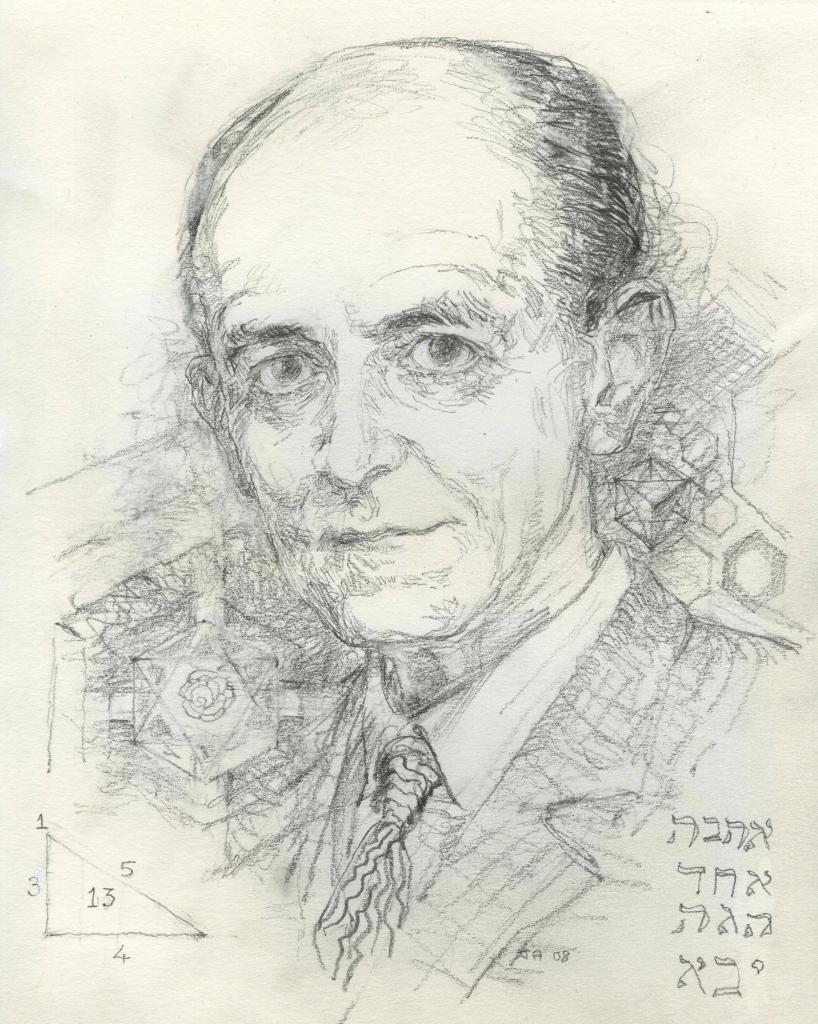
In addition, a number of notable criticisms have been raised to question the claim that Case co-wrote The Kybalion. First, when Professor Deslippe’s (2011) ran The Kybalion through the software in comparison to all of Case’s books, the software found no significant similarities in syntax or word choice between the texts at all. In contrast, the full Kybalion text bears the semantic, dictional, and syntactic stamp of Atkinson and the book is, in content as in form, continuous and consistent with his other literary output (“Three Initiates” in Deslippe, 2011). Therefore, the logical inference is that Case could not have done any of the writing of The Kybalion; otherwise, his lexical, semantic, syntactic, or other peculiarities would have appeared in the text and been detected by the software analysis as was the case for Atkinson (Deslippe, 2018).
Second, by process of elimination, it follows from the above that even if Case was involved in the composition of the text, it could have been in little more than a consulting/editing capacity with Atkinson doing all of the writing. Even this is doubtful, however, for as Professor Deslippe (2011) points out, Atkinson would not have needed Case’s help to write The Kybalion, as he was a prolific author already at the time, nor would he have needed Case’s assistance with editing, as Atkinson was already a seasoned editor of multiple magazines in 1907. Moreover, Case was decades younger than Atkinson in 1907 and much less experienced and had also just met Atkinson in 1907; there is no clear reason to suggest Atkinson would have sought out Case’s help after already publishing countless books by himself.
Third, although there is some circumstantial evidence that Case and Atkinson may have attended publishing receptions together in 1907, that Case bore a distant relation to Atkinson’s wife, and that the two may have known each other at the time, there is no concrete evidence (1) that Case worked as Atkinson’s secretary or editor in 1907, or (2) that the two collaborated on any jointly-authored pieces in 1907 let alone on Kybalion (Deslippe, 2011). Circumstantial evidence of the two knowing each other as acquaintances and having spoken at receptions is insufficient grounds to argue that they co-wrote Kybalion, especially since the objective software-based analysis found no linguistic similarities at all to suggest that Case had left any authorial imprint on the text (Deslippe, 2011).

Fourth, authors such as Nick Farrell (2014) have pointed out that the only people who claim that Case told them he worked on The Kybalion were intimates of Case (e.g. Ann Davies) or his other students who had a history of mythologizing Case, motivation to draw on the popular prestige of The Kybalion to aggrandize Case’s reputation and bolster BOTA, and no concrete evidence to substantiate the claim. They have also noted that even if Case did tell them he worked on The Kybalion, he may have been exaggerating as he often had a tendency to do both in his writings and in conversation with other Adepti (e.g. see his letters to Israel Regardie for some of many examples). Others, such as a well-known BOTA Adept whom this author consulted for the purpose of this article and who asked this author not to be quoted by name, have questioned the reliability of Dr. Clark’s claims about the Case-Kybalion connection due to what he called “Dr. Clark’s participation in “myth-building” around Case and the lack of any solid evidence.” As this author is not a BOTA member and has not spoken with Dr. Clark, he cannot comment on this point, although he does respect Dr. Clark’s work on the Fraternity of the Hidden Light (FLO or Fraternitas L.V.X. Occulta).
In any case, criticisms such as the above and the absence of any definitive evidence to the contrary led Professor Deslippe (2011) to favour an Occam’s Razor approach and suggest that The Kybalion was entirely the creation of Atkinson posing as “Three Initiates” in a nod to the Thrice-Great Hermes Trismegistus of Hermetic legend. Similarly, while this author respects BOTA and its members and, like Fox Mulder in the X-Files, “Wants to Believe” that Case had a role in authoring The Kybalion, the evidence in support of such a connection appears circumstantial, tenuous, and insubstantial at best.

D. Other “Initiates?”: Exploring Other Theorized Contributors to the Authorship of The Kybalion
Could any other authors have contributed to The Kybalion? Over the past century since the text’s release, this tantalizing question inspired a flood of fervent theorizing from occultists as they sought the occluded origins of The Kybalion. As a result, many other candidates for members of the “Three Initiates” have been proposed over the years, to which we will now turn in an attempt to critically evaluate the historical evidence for and against their authorial candidacy.
A third candidate for a member of the “Three Initiates” is Elias Gewurz (1875-1947), a Polish-American Theosophist and author of works on the Hermetic Qabalah. The strongest pieces of evidence for the Gewurz theory seem to have been (a) that Gewurz knew William Walter Atkinson from the Theosophical circles they both frequented and, (b) that the Yogi Publication Society, which published many of Atkinson’s works, also published Gewurz’s The Hidden Treasures of Ancient Qabalah among other texts (e.g. his Diary of a Child of Sorrow (1918).
However, the timeline does not work out as Elias Gewurz was in Australia in 1907 when Atkinson was writing The Kybalion. Moreover, the official records of the Archives of the Theosophical Society in America note that Gewurz only appears in the United States in June of 1908 as per Membership Ledger Cards Roll 3, number 01994. In addition, this author was unable able to find any writings of Gewurz written before 1916, certainly none written in America. The earliest identifiable American Gewurz publication was “Comments on the Light of the Path,” which was published in The Messenger in September of 1916, 8 years after Atkinson’s anonymous publication of The Kybalion.
Further problematizing this theory, Deslippe’s (2011) analysis did not find any textual similarities between Gewurz’s writing and The Kybalion. Finally, Gewurz was primarily focused on the Kabbalah, which scarcely enters into the subject matter of The Kybalion at all, as we noted above. Therefore, for textual, contextual, subject matter, and geographical reasons–that is, the problem of Gewurz being in Australia when Atkinson was writing Kybalion in 1907–Gewurz’ candidacy as potential contributor to The Kybalion can be confidently ruled out.

To carry on our investigation, Paul Foster Case’s wife Harriet Case (born in 1885)–not to be confused with his later wife Harriet Bullock Case, whom he married in 1943, long after the release of The Kybalion–has been suggested as a fourth possible contributor to The Kybalion, by some B.O.T.A members. However, there is no apparent imprint of Ms. Case’s thought on the text and, from the little we know of it, no evidence of lexical or syntactic features of her writing (Deslippe, 2011). Moreover, we know that Ms. Case was born in 1885 from no less a source than the 1920 U.S. census itself. Therefore, she was only 22 years old in 1907, when the 45 year-old Atkinson was working on The Kybalion and not a major occultist who would have come into the orbit of Atkinson except, perhaps, via her association with Case.
To be charitable to those who endorse this theory, it is conceivable that Paul Foster Case and Harriet Case might have spent time discussing the foundational ideas of The Kybalion with Atkinson together or perhaps helping with editing, but if Harriet Case exerted any influence on the text, it would have likely been comparatively minor. Furthermore, there is no evidence of any correspondence between Atkinson and Harriet in the period, nor is there any evidence of Harriet Case doing any esoteric writing in 1907 when Atkinson was working on the text. In short, this author has not found any concrete evidence that Ms. Case’s alleged influence on The Kybalion was anything but a highly unlikely conjecture.
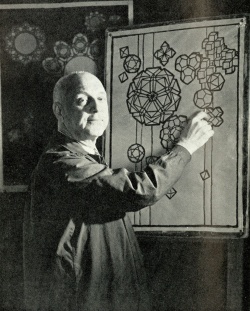
Claude Bragdon (1866 – 1946) has also been proposed as a fifth possible contributor to The Kybalion. Bragdon was a fascinating individual who applied his mystical understandings of the world, informed largely by Theosophy, to the work of practical architecture. Nor was he an architect of simply local renown; Bragdon enjoyed a national reputation as an architect working in the progressive tradition associated with Louis Sullivan and Frank Lloyd Wright (Taylor, 2018).
In addition to being a visionary architect, Bragdon was also an artist, writer, philosopher, and stage designer who worked within the then-innovative tradition of New Stagecraft, a minimalistic approach to stripped-down stage design that aimed to “let plays speak for themselves” (Taylor, 2018). Bragdon’s studies of Theosophy influenced both his set designs and his architecture. Indeed, in both artistic domains, Bragdon aimed to embody a Theosophical notion of Beauty in forms that would advance the spiritual consciousness of their beholders. In 1907-1909, Bragdon was also publishing pamphlets that aimed to spread Theosophy to a broader audience (Bragdon, 1910). Summarizing the above, the great architect-occultist’s autobiography More Lives Than One divides his early existence into four “lives,” all building on each other and often overlapping, that is, architectural life, literary life, theatrical life, and occult life.
Could Bragdon’s “occult life” have included contributing to The Kybalion? Although Bragdon apparently met Paul Foster Case in 1900, it is not clear that he had any extensive communications with William Walker Atkinson, if indeed he had any at all. Moreover, the idea that Bradon was one of the ”Three Initiates” runs into a significant problems of both chronology and geography. While Atkinson was working on The Kybalion in Chicago in 1907, Bragdon was busy in Rochester, New York working on a new building for the First Universalist Church (Ellis, 1994).
As an intriguing side note, Bragdon’s design for the Church in question was a remarkable fusion of Eastern and Western spiritual ideas; he combined Christian notions with Hindu temple design elements (e.g. the Temple as symbolic embodiment of Purusha, or Cosmic Body) and an understanding of Gothic mysticism as interpreted through the work of Rosicrucian Hargrave Jennings. To this point, Bragdon’s 1902 work The Bodily Temple includes a diagram showing the “Symbolism of a Gothic Cathedral” from Hargrave Jennings’ The Rosicrucians (1870):
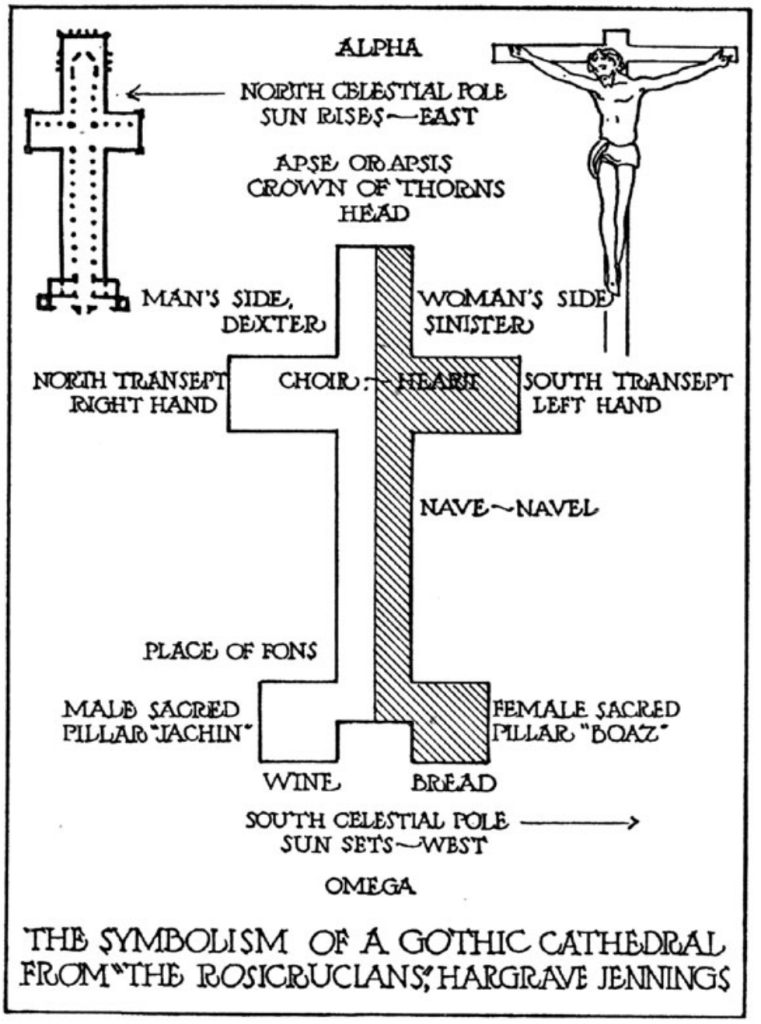
This diagram is interesting as it factors the balance of “Masculine and Feminine Polarity” into the structure of the Christian cathedral in a way that presages The Kybalion’s “Principle of Gender” and “Principle of Polarity.” However, the mere interest in gender and polarity in Bragdon’s work is not sufficient to suggest that he contributed these ideas to Atkinson’s Kybalion; such ideas were of widespread interest in Theosophical and New Thought circles at the time and recurred in the writings of many of Bragdon’s contemporaries (Deslippe, 2011). Bragdon’s First Universalist Church also notably features a rose window that beams light directly into the center of the cross-structure of the Church; a clear reference to the Rosicrucian emblem of the Rose-Cross, likely also influenced by Jennings’ thoughts on the subject (Ellis, 1994).

In any case, and returning to the focus of the present inquiry, Bragdon was thoroughly occupied with the design and construction of First Universalist Church in 1907 when Atkinson was in another city writing The Kybalion. Moreover, Bragdon’s literary output at the time, like his architectural work, was also focused on the Gothic Cathedral, for in 1907, he was working on his article “The Gothic Spirit” which would go on to be published in Christian Art magazine Volume 2, Number 4 in January of 1908. Furthermore, since there is no evidence of any significant contact between Atkinson and Atkinson in 1907, he can be safely ruled out as a contributor to The Kybalion. The nail in the coffin of the Bragdon theory is that the software-based comparative analysis did not reveal any textural similarities between The Kybalion and any of Bragdon’s works, suggesting that the text does not bear his authorial imprint.

Sixth, perhaps the most amusing candidate to be proposed as a contributor to The Kybalion is the famous occult author Manly P. Hall (1901-1990). Unfortunately for this theory, however, when the 45 year-old Atkinson was writing The Kybalion in Chicago in 1907, Hall was not only living in another country, namely Canada, but was also only 8 years old (Sahagun, 2008). Despite Hall’s precociousness, it is hard to fathom how he might have contributed to The Kybalion under such considerable geographic–and dare we say pediatric–constraints.
A seventh candidate, Marie Corelli (1 May 1855 – 21 April 1924), a prolific author of many metaphysical novels was suggested as a possible member of the “Three Initiates” by Art Kunkin (1997). Correlli’s father apparently had some influence in Rosicrucian circles; however, this author has not been able to find any concrete evidence to support Corelli as having had a part in the authorship of The Kybalion and the software-mediated comparative analysis found no textual similarities between any of her works and The Kybalion. Indeed in 1907, when Atkinson was working on The Kybalion, Corelli was hard at work across the ocean from Atkinson in Stratford-Upon-Avon, UK on finishing Delicia & Other Stories, which she would go on to publish that same year. Moreover, there is no evidence of any correspondence between her and Atkinson, so this theorized “Initiate” also appears to have had nothing to do with The Kybalion.

Eighth, in addition to the above candidates, Ann Davies, who succeeded Paul Foster Case as head of the B.O.T.A., has been mentioned as a possible member of the “Three Initiates.” Unfortunately, however, she was only born in 1912 – four years after The Kybalion‘ was published. Therefore, unless the unborn Davies telepathically collaborated with Atkinson from the Astral Plane before she was even born, the Ann Davies authorship hypothesis can be safely rejected as historically impossible.
A ninth candidate for a member of the “Three Initiates,” again from the Alpha et Omega Golden Dawn tradition like Michael Whitty (see Section G), is Dion Fortune (6 December 1890 – 6 January 1946). Fortune was a formidable occult figure in the 20th century; besides having gone through the Golden Dawn initiations, she was also a co-founder of the Fraternity of the Inner Light, notable occult author, and novelist. Unfortunately for those who hope to see her as a Kybalion contributor, she was only 17 years old and in the UK when Atkinson was working on The Kybalion in Chicago, USA in 1907.
Furthermore, there is no evidence that the much older Atkinson corresponded with the adolescent Fortune around the time of the writing of the book. Indeed, as noted above, Dion Fortune’s biographer Alan Richardson (2007) notes that Fortune’s family arrived in London in 1906 and were still there the following year. The teenage Fortune had no opportunity to meet the older Atkinson, who was in the USA while she was in the UK. The final coup de grâce to the theory that Fortune contributed to The Kybalion was that the teenage Dion Fortune was not yet interested in Hermetics in 1907, but rather Christian Science. In fact, the only piece of her writing that dates to around this time appeared only in 1908 and was a poem called “Angels” that appeared in Christian Science Journal, Volume 26, April 1908 (Richardson, 2007). For all of these reasons, she, too, can be ruled out as having been one of the “Three Initiates.”
E. The Man Who Knows: A Stage Magician “Initiate”?

Our tenth candidate Claude “Alexander” Conlin (1880 – August 5, 1954) has the distinction of being the only stage magician among the theorized Kybalion “Initiates.” Besides an illusionist, Alexander was also well-known for being a mentalist, proponent of crystal gazing, and, like Atkinson, a New Thought author.
Who was this elusive worker of stage and mentalist magic? Conlin was born in 1880 to Irish parents in a small town called Alexandria (Forzoni, 2016). From his teenage years, Alexander found himself drawn to magic books, like Hoffman’s Modern Magic (1876) in his local library. Always something of a rebel against the standards of society, Conlin was expelled from high school at the age of 17, fled his home to travel to the East against his parents’ wishes and “found work at the most famous spiritualist resort of Lily Dale, near Cassadaga, New York” (Forzoni, 2016). While there, Conlin soon learned the secrets of the “medium’s'” tricks, from slate-writing to billet-switching, spirit collars, rope ties, and other tricks to “take advantage of the gullible,” in Alexander’s words.
During this time, Conlin also developed a special interest in the psychology of stage magic and mediumship, that is, how to produce surprising effects by working with the minds and mental illusions of the audience (Charvet, 2007). After a failed attempt to cash in on the Alaskan Gold Rush, in which he allegedly shot gangster Jefferson Randolph ‘Soapy’ Smith, Alexander went on to work as a faro dealer, an assayer of gold, a cashier and a psychic who told prospectors he could help them find gold with his “psychic powers” (Forzoni, 2016).
After a first stage magic performance in 1898 at the tender age of 18, Conlin went on to take up the stage name of “Alexander the Great,” either naming himself after the Macedonian conqueror, his friend Alexander Pericles Pantages, or his home town of Alexandria, according to different accounts (Forzoni, 2016). Alexander began his stage performances in earnest in 1902 in Seattle, performing in Orientalist garb wearing a turban in vaudeville. Forzoni (2016) notes that Conlin’s act was “one of the most successful and profitable acts of its time” and describes Alexander as “a performer who once rigged a stage with underground wires to receive electronic signals in the 1920s, used concealed earpieces under his turban, and hid listening devices in the toilets of theatres to gain vital information to be used later in his shows.”
Beyond his work on the stage, Conlin became notorious for the life of crime and scandal in which he embroiled himself. In addition to an alleged gangster-shooter, as we noted above, the “great Alexander” was also a serial adulterer, having had–according to his eldest son–a total of fourteen marriages, with as many as 3 happening consecutively, unbeknownst to the women involved. Alexander was also a suspected murderer, an alleged money launderer, a grand larcenist, a drug smuggler, and, as a consequence of all of the above, the bearer of a significant FBI dossier (Forzoni, 2016; Charvet, 2007).

Poster for a Magic Show by Claude “Alexander” Conlin.
Could this ambivalent figure on the fringes of society have contributed to The Kybalion? Proponents of this theory have pointed out that Alexander was invested in New Thought, and indeed, in striking violation of the hallowed dictum that “a magician never reveals his tricks,” wrote a massive tome, The Life and Mysteries of the Celebrated Dr. Q (1921), exposing the mechanics behind most of the leading mentalist tricks of his day (Charvet, 2007). As “Dr Q” illustrates, Conlin, like Atkinson, sometimes employed pseudonyms to publish works anonymously; he variously operated under the names of Alexander, C. Alexander, Dr. Q., the Crystal Seer, and the Man Who Knows (Forzoni, 2016).
Unfortunately, however, and similarly to other theories we have considered so far, the Alexander theory runs into logistical problems. While Atkinson was working on The Kybalion in Chicago in 1907, Alexander was in San Francisco with his third wife, the 17 year-old Della Martell (Forzoni, 2016). During this key year, Conlin’s time was absorbed in the enterprise of posing as a psychic to the many San Franciscans who were grieving the loss of loved ones who died in the catastrophic 1906 San Francisco earthquake.
As Odell and Weidenmier (2004) point out in their fascinating article “Real Shock, Monetary Aftershock: The 1906 San Francisco Earthquake and the Panic of 1907,” the 1906 earthquake substantively impacted the people and economy of the city. Economically, the San Francisco earthquake and fire of April 1906 caused massive damages estimated to be between $350- $500 million, or 1.3 to 1.8 percent of U. S. GNP in 1906, and spurred the United States to create the Federal Reserve system to bring elasticity and stability to the American dollar (Odell & Weidenmier, 2004). The city was also physically devastated by the 8.3 Richter-scale earthquake because most of the buildings in San Francisco at the time were made of wood and the violent tremors ignited fires that devastated countless homes and places of business (Odell & Weidenmier, 2004). In the wake of these conflagrations, 1,500 people lost their lives, leaving many grieving loved ones behind (Commercial and Financial Chronicle, October 19, 1907). When these bereaved individuals yearned to communicate with their dearly departed loved ones, Alexander was happy to swoop in to “help them do so” — for a fee (Forzoni, 2016).

San Francisco in 1906 in the wake of the earthquake and fire of April, 1906.
In any case, given that there is no evidence that Alexander corresponded with Aktinson in 1907, given the fact that he was busy with other work and personal scandals in a different city across the country from Atkinson, and given that the software-enabled analysis found no evidence of any textual similarities between Alexander’s writing and The Kybalion, the theory of his having contributed to the text can be safely dismissed (Deslippe, 2011; Forzoni, 2016).

Mabel Collins (1851-1927).
F. A Novelist Among the Three?: The Case Against the Mabel Collins Authorship Theory
Eleventh, the novelist Mabel Collins (September 9, 1851 – March 31, 1927) has also been put forward a possible contributor to The Kybalion. Like Atkinson, Collins was active in Theosophical circles, and she was the author of at least 46 books, including Light on the Path (1885), which was popular among Theosophists. Collins certainly had occult interests; indeed, she famously helped Helena Petrova Blavatsky edit the Theosophical journal Lucifer in London and wrote a book entitled The Blossom and the Fruit: A True Story of a Black Magician (1889). Notable books by Collins also include The Blossom and the Fruit (1888), The Idyll of the White Lotus (1890), Morial the Mahatma (1892), Suggestion (1892), The Star Sapphire (1896) and The Story of Sensa (1913).
During the First World War, Collins wrote a book entitled The Crucible (1915), which helped promote supernatural occurrences on the Western Front; in this fascinating work, she quoted one young officer as saying: “I had the most amazing hallucinations of marching at night, so I was fast asleep, I think. Everyone was reeling about the road and seeing things…. I saw all sorts of things, enormous men walking towards me and lights and chairs and things in the road” (Collins, 1914).
Collins also reported some interesting occult experiences and dramatic clashes with famous 19th-century occult figures like H.P. Blavatsky (1831-1891). For example, Collins told Theosophist A.P. Mabel that she experienced “Egyptian priests crossing her room as she was working” on the Banner of Light (Farnell, 2003). Blavatsky believed that one of her “Hidden Masters”–the hilariously named Master Hilarion–had appeared to Mabel Collins in 1884 and had dictated to her the conclusion of The Idyll of the White Lotus and the whole of Light on the Path.
Collins herself appeared intrigued by this idea at first, as evidenced by a letter she wrote in 1885, in which she expressed belief in Blavatsky’s theory (Farnell, 2003). Collins also worked hard to gain entry into the Esoteric Section of the Theosophical Society, but was only a member for 4 days before Blavatsky expelled her for “treachery and disloyalty.” Her crime? Flirting with reporter Michael Angelo Lane (Farnell, 2003).
After a series of progressively escalating conflicts with Blavatsky, Collins took Blavatsky to court on charges of libel. The two had a dramatic falling-out, which was amplified by Elliot Coues’ defense of Collins and opposition to Blavatsky; the latter battle culminated in a full-page expose of Blavatsky in the New York Sun on July 20th 1890 (Farnell, 2003).
Could Mabell Collins have contributed to The Kybalion? There is no evidence to suggest that she did. Her works bear no syntactic, lexical, or other linguistic connections with The Kybalion. Moreover, as in many of the cases we have considered, the historical circumstances do not align for Atkinson and Collins. For one thing, Collins was not even in the United States, let alone Chicago, either in 1907 when Atkinson was working on The Kybalion or in 1908 when the book was released (Deslippe, 2011; Farnell, 2003). We know this, because during this time, she was in Holloway, London, waging a fervent campaign against vivisection, which is attested by a number of anti-vivisection pamphlets she wrote during this time. This point is also buttressed by letters she wrote in the period to suffragette and activist Charlotte Despard in the same pivotal years (Farnell, 2003). Collins’ collaboration with the suffragette is clearly documented in Collins’ book Despard (1908), which was co-authored with Despard herself, and which the two wrote and published in the period from 1907 to 1908 (Farnell, 2003). Therefore, since there is no textual evidence that Collins contributed to The Kybalion, since she was in a different country at the time, and since she was thoroughly engaged in both extensive activism work and writing Despard, she can be safely ruled out as a possible member of the “Three Initiates.”

Michael Whitty’s (1862-1920) photograph and signature.
G. Another Alpha et Omega (AO) Adept?: Analyzing the Whittyan Authorship Theory
The twelfth and final candidate we will consider in the present study is Michael James Whitty (bef. 1862 – died December 27, 1920 in Los Angeles, California), an Adept from Moina and Samuel Liddell MacGregor Mathers’ Order of Alpha et Omega. As his Memoriam in an issue of Azoth magazine from 1920 notes, Whitty was the founder and editor of the Azoth magazine; its other main editor was his friend Paul Foster Case, whom we have already discussed. In an interesting commonality with Mabel Collins, H. Kemlett Chambers (1920) notes that Whitty also “addressed legislatures and medical societies in support of movements to mitigate the horrors of unnecessary vivisection by regulating its practice.” Chambers (1920) adds that Whitty also strove “to put an end to deliberate and harmful medical experimentation upon the poorer class of hospital patients; even the interests opposed to those reforms listened with reluctant respect to his arguments.” Whitty, like Bragdon, was a passionate Theosophist; indeed, he was, for a time, elected the President of the New York branch of the Theosphical Society. For Chambers’ heartfelt remarks on Whitty after the passing of his friend, see Azoth Vol. 8 (No. 2)., February, 1921.
The theory that Michael Whitty helped author The Kybalion was intriguing to this author because esteemed occult author and G.H. Frater, Pat Zalewski (1996) stated, in correspondence archived by Levity, that he suspected that Whitty may have been one of the “Three Initiates.” Dan Denlinger (1997) points out that Zalewski’s sources for this claim were Dr. Paul Clark, author of Paul Foster Case: His Life and Works (2013) as well as “a few other BOTA members in New Zealand.” Dr. Clark was trained by BOTA Adept Ann Davies, whom we mentioned above, and who was herself Paul Foster Case’s protégé (Clark, 2013). We have already analyzed the theories surrounding Case and Davies, but what of Whitty?

Those who endorse the theory that Whitty was one of “The Three Initiates” gesture towards a number of interesting points. First, Wood (1997) indicates that Whitty and Case knew each other intimately because both served in the same Chicago Temple of an off-shoot of the post-schism Hermetic Order of the Golden Dawn, Alpha et Omega.
To quote Wood (1997), “Michael Whitty remained a faithful A.O. member until death, and he was Praemonstrator of Thoth-Hermes Temple No. 9 or Temple No. 8 according to an S.L. MacGregor Mathers minute book from Ahathoor Temple until his death in Los Angeles. Paul Case succeeded Whitty as Praemonstrator of that Temple, but resigned from the office after a few months, and within a year, Case was expelled from the A.O. by Moina Mathers for “trying to cause dissension within the Order.” As a side note of historical interest to this point, this author has read the original letter that Chief Moina Mathers wrote to expel Paul Foster Case from the Alpha et Omega Order, in which she states that Case was being expelled also not only for causing dissension, but also for his disparaging remarks against MacGregor Mathers, his attacks on the Enochian system, and his claim that the RR et AC was not a real Rosicrucian Order.
Second, Clark (2013) states that Case’s widow Harriet Bullock Case told him that Michael Whitty worked with Case and Atkinson on The Kybalion. Unfortunately, however, the Whitty co-authorship hypothesis faces some notable challenges. First, as occult scholar Robert Word (1997) has noted, in 1907, when Atkinson was working on The Kybalion in 1907, (1) Whitty was in Australia, not in America, and, more devastatingly for this theory, (2) Whitty and Atkinson had not yet met. This latter fact was confirmed by occult author and editor Tony DeLuce (2024). Moreover, to be fair to the BOTA perspective, Clark (2013) himself states that he was told by several reliable sources in BOTA that Whitty had not yet met Case in 1907, but only in 1918.
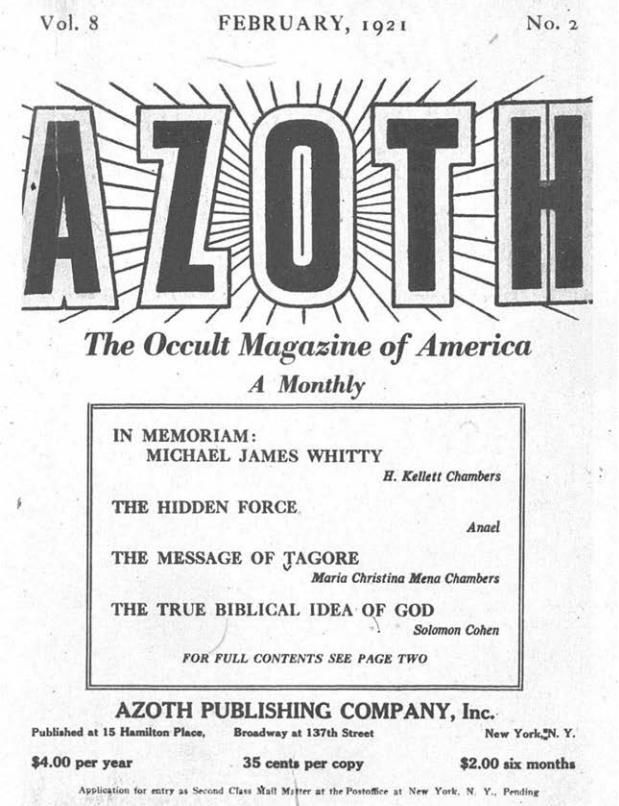
Cover of the February, 1921 edition of Azoth: The Occult Magazine of America (Vol 8., No. 2), featuring an In Memoriam tribute to Michael James Whitty by H. Kellett Chambers.
Indeed, we know that Whitty only moved from Australia to New York after 1908; that is, The Kybalion had already been published when Whitty came to the United States (Denlinger,1997). Moreover, the software-mediated analysis comparing Whitty’s writings with The Kybalion found no stylistic, lexical, or syntactic similarities between The Kybalion and any of Whitty’s writings. Furthermore, there is no evidence of correspondence between Whitty and Atkinson dating to the period when we know Atkinson was working on The Kybalion, since they had not yet met Therefore, it would appear that the Whitty theory can be safely dismissed as historically impossible (given the timeline of when Case met Whitty in 1918), geographically implausible (given the distance between Chicago and Australia), and textually unsupported (given the results of the digital comparative linguistic analysis).

Seal of the Hermetic Brotherhood of Luxor, showing the Sun, Moon, the Four Kerubim, Hexagram, an Ouroboros, and a Serpent in the Letter S. The serpent in the shape of the letter ”S” here is likely derived from the influence of Hargrave Jennings’s book The Rosicrucians: Their Rites and Mysteries in which the author notes that ”the three most celebrated emblems carried in the Greek Mysteries were the Phallus ”I,” the Egg ”O,” and the Serpent ”S,” or otherwise the Phallus, the Umbilicus, and the Serpent.” As Samuel Robinson (2019) notes, Jennings’ book was published in 1870, the same year that Paschal Beverly Randolph founded the Brotherhood of Eulis. Immediately afterwards, the first Grade of the Hermetic Brotherhood of Luxor was named the ”Grade of Eulis.” Jennings and Randolph both influenced the Hermetic Brotherhood of Luxor’s teachings and symbols. Indeed, Jennings was the teacher of prominent Brotherhood of Luxor member Peter Davidson. Some of these figures will return in Section H of the present analysis given below.
H. Atkinson and The Hermetic Brotherhood of Luxor?: Teike Van Baden’s (2022) Analysis of The Kybalion’s Origins in Florence Huntley’s Harmonics of Evolution (1897)
Before we close the present study, there is one final piece of the puzzle of Kybalion authorship that remains to be explored. 11 years after the publication of Professor Deslippe’s study, that is, in 2022, Pansophers contributor Teike Van Baden published a fascinating article entitled “The Kybalion and its Hermetic Brotherhood Origins.” In this article, Van Baden answers an interesting question that has long lingered in the minds of Kybalion researchers: given that there is no evidence that an ancient book called ”The Kybalion’‘ existed, from which sources did Atkinson derive his “Hermetic laws”?
As part of an answer to this question, Van Baden (2022) shared a bombshell revelation that he uncovered when studying the Hermetic Brotherhood of Luxor’s original documents and the records of Pansophers oral traditions shared within the HBoL, namely, that William Walker Atkinson had in fact been a member of the Chicago section of the Hermetic Brotherhood of Luxor. Even more striking, Van Baden (2022) explained that it was from the Hermetic Brotherhood’s Chicago study circle that Atkinson derived the material that would later form the substantial basis of The Kybalion.
In his analysis, Van Baden (2022) points out that The Kybalion’s ‘‘Hermetic Laws” are largely based on the Laws Florence Huntley provided in her book The Harmonics of Evolution. This text was published in 1897, 11 years before The Kybalion. Huntley was married to her Initiator, John Emmet Richardson; both she and Richardson were members of the Hermetic Brotherhood of Luxor. Van Baden (2022) provides evidence through textual comparison with Huntley’s text that The Kybalion’s Principles of Mentalism, Vibration, Polarity, and Gender all have analogues in Huntley’s Harmonics of Evolution. He adds that The Kybalion’s Principle of Correspondence was expressed in the 1896 book Celestial Dynamics by Hermetic Brotherhood of Luxor Secretary Thomas Burgoyne, a book which predated The Kybalion’s publication by 12 years. Of course, Burgoyne’s Celestial Dynamics was itself interpreting the famous maxim from the Emerald Tablet of Hermes Trismegistus which says that “quod est superius est sicut quod est inferius, et quod est inferius est sicut quod est superius, ad perpetranda miracula rei unius” (“What is above is like what is below, and what is below is like what is above, to enact the wonders of the One Thing”).

The cover of Thomas Burgoyne’s book The Light of Egypt (1889). Note the similarity of the cover logo to the Seal of the Hermetic Brotherhood of Luxor as shown above.
To synthesize the work of the different researchers we’ve examined so far, Van Baden’s (2022) findings can be illuminatingly integrated with the findings of Mary K. Greer (2009). As we noted above, Greer found that The Kybalion’s 7 Laws were also derived from “an introduction to a translation of Hermetic writings by Anna Kingsford and Edward Maitland called The Virgin of the World of Hermes Mercurius Trismegistus (1885).” Indeed, we recall that Greer (2009) discovered that ”in the short introductory essay to The Virgin of the World (1885), called “The Hermetic System and the Significance of its Present Revival,” we find nearly the same seven (unnumbered) laws, doctrines or principles that are found in The Kybalion.” To this point, Richard Smoley (2011) notes the following similarities between The Kybalion and Maitland’s Introduction to The Virgin of the World of Hermes (1885):
“Maitland asserts that consciousness is “the indispensable condition of existence,” and that matter “is a mode of consciousness,” which certainly resonates with The Kybalion’s doctrine of Mentalism. Maitland also mentions “the Law of Correspondence between all planes, or spheres, of existence.” He also speaks of “the doctrine of Karma,” which dictates “the impossibility either of getting good by doing evil, or of escaping the penalty of the latter” – an obvious parallel to The Kybalion’s “Law of Cause and Effect.” In light of these resemblances and The Kybalion’s insistence that it contains the essence of Hermetic teaching, it is very likely that Kingsford and Maitland’s work was at least one of The Kybalion’s sources.”
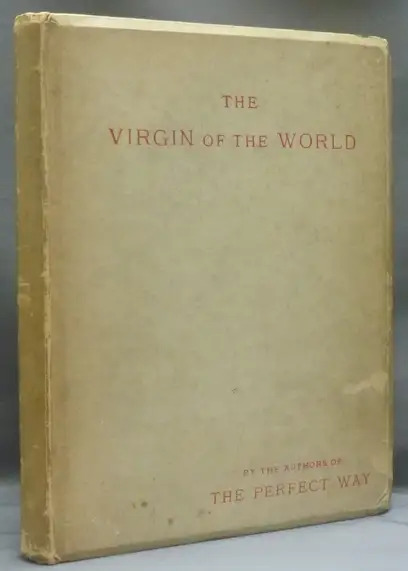
First Edition of Kingsford and Maitland’s Virgin of the World of Hermes (1885).
As it turns out, in Chicago’s Hermetic Brotherhood of Luxor circle, all three of these texts — that is, Kingsford and Maitland’s Virgin of the World of Hermes (1885), Burgoyne’s Celestial Dynamics (1896) and Huntley’s Harmonics of Evolution (1897) — were studied and that Atkinson had access to them (Van Baden, 2022; also verified to this author in correspondence with Van Baden (2024). The Hermetic Brotherhood of Luxor’s study of the Virgin of the World of Hermes (1885) was additionally confirmed to this author in correspondence with Pansophers researcher and author Samuel Robinson (2024).
Indeed, Van Baden (2022) revealed that William Walker Atkinson was studying these texts and involved with the Hermetic Brotherhood of Luxor’s Chicago circle within the time-frame in which he was writing The Kybalion. While Atkinson was active in Chicago in 1907, a chapter of the Hermetic Brotherhood of Luxor called the Hermetic Brotherhood of Atlantis, Luxor, and Elephantae was operating; the Chicago circle was led by Myra and W.P. Phelon until they passed away in 1896 and 1904 respectively (1907). According to the archives of the Hermetic Brotherhood of Luxor, the Chicago group was still operating under their students in 1907; indeed, Albert Sidney Raleigh, also known as Hach Nactzin El Dorado Can, became head of the Hermetic Brotherhood of Atlantis and kept the Chicago circle going until 1913 (Demarest, 2017). Nancy McKay Gordon (1850-1931) also remained active with the Chicago HBoL group around the same time; she published a series of Twelve Centers of Consciousness lessons and distributed them to the Chicago Hermetic Brotherhood of Luxor members between 1900 and 1908, the latter being the year when The Kybalion was published (IAPSOP, 2011).
The Hermetic Brotherhood’s W.P. and Myra Phelon moved through the same Hermetic and Theosophical circles as Atkinson and also shared his interest in New Thought. Like Atkinson, the Phelons were fellow publishers of occult magazines; the couple published a monthly journal called The Hermetist in Chicago. Atkinson was not only an avid reader of The Hermetist and attended Chicago Theosophical Society events, but even used the term “the Hermetist” in The Kybalion itself. In fact, the word appears a total of 42 times throughout The Kybalion. In The Hermetist magazine, the Phelons promoted and advertised the work of New Thought authors Annie Rix Militz and Ursula Gestefeld. Indeed, as yet another example of just how intertwined the Chicago New Thought, HBoL, and Theosophical communities were, like Atkinson, Annie Rix Militz was a fellow New Thought magazine publisher; she published The Master Mind Magazine, which Atkinson read and which quoted him frequently in both articles and advertisements (e.g. see The Master Mind Vol 8. No. 6, published in 1915). 3 years after the publication of this latter issue of The Master Mind, William Walker Atkinson published a book called Master Mind in 1918 under the pseudonym of Theron Q Dumont. The overlaps and cross-references in this period of Chicago occult literary history are truly dizzying enough to make one’s head spin.
As yet another example of this overlap, Like Atkinson, W. P. and Myra Phelon, as well as many other members of the Chicago Hermetic Brotherhood of Luxor, were involved in the Chicago branch of the Theosophical Society. Here, Atkinson met some of the authors he published in his magazines such as Elias Gewurz. Both W.P. and Myra Phelon became members of the Theosophical Society on November 11, 1884; they were active in the Chicago Branch, which Atkinson frequented, and of which Dr. Phelon was the Corresponding Secretary (TSGMR 1875-1942). The Phelons helped to form the Ramayana Theosophical Society on July 27, 1887. Among other texts, the Ramayana group studied Atkinson’s works under the pseudonym of Yogi Ramacharaka, such as his book Raja Yoga, which was itself influenced by the work of Hermetic Brotherhood of Luxor member Genevieve Stebbins (Nichols, 2013).
To this point, Kimberly Nichols (2013) showed that Atkinson drew on Stebbins’ teachings on yogic posture and breathing in her Dynamic Breathing and Harmonic Gymnastics (1892) to write Raja Yoga. Stebbins was a close associate of Thomas Burgoyne and co-founded the Hermetic Brotherhood of Light with him and other HBoL members. As we noted, Burgoyne was the author of The Celestial Dynamics (1896), which influenced Atkinson’s formulation of the Law of Correspondence in The Kybalion (Van Baden, 2022). Like Atkinson, Militz, and W.P. Phelon, Burgoyne was an occult magazine editor; he published The Occult Magazine. In the Ramayana Theosophical Society, W.P. Phelon served as President. The group’s meetings took place at 629 Fulton Street, which also served as W.P. Phelon’s doctor office, the editorial office of The Hermetist, and the business address of the Hermetic Publishing Company (Godwin, 1995; TSGMR, 1875-1942).
As if the Theosophical, New Thought, and Hermetic connections to Atkinson and the HBoL were not yet sufficient, Atkinson’s editorial work also brought him into contact with the Hermetic Brotherhood of Luxor members in Chicago. Indeed, right before Atkinson became the editor of Herbert A. Parkyn’s magazine Suggestion, there were mentions of ”Hermetic Brothers” attending a Full Moon Meeting of the Hermetic Brotherhood of Luxor published in the Suggestion (Deslippe, 2011). Garrett (2012) indicates that the Phelon group had shortened their name to the Hermetic Brotherhood by this time. Moreover, the Hermetic Brotherhood of Luxor’s Chicago members and the editors and authors of the Suggestion interacted with Parkyn’s Chicago School of Psychology, of which Atkinson was a student (Deslippe, 2011). The connections in this Chicago esoteric web were tightly-wound indeed.
Thus it was that by the early 1900s, all of the currents of esoteric thought that would find their confluence in Atkinson and result in the creation of The Kybalion (1908) were in place. Besides his love for New Thought and Theosophy, Atkinson’s budding interest in unifying New Thought with “the Hermetic philosophy” attracted him to the Chicago chapter of the Hermetic Brotherhood of Luxor, for the group not only claimed to be custodians of this philosophy, but also to have an initiatory descent from ancient Hermetic Masters (Godwin, 1995; Van Baden, 2022. Like The Kybalion‘s own pretended ancient origins, this “ancient lineage” was undoubtedly fictionalized for prestige. However, the absence of an “authentic ancient lineage” was no impediment to Atkinson, because the 19th century materials the Brotherhood studied were sufficient for his literary purpose; these were the Kingsford and Maitland (1885), Burgoyne (1896) and Huntley (1897) texts that would go on to form the substantial core of The Kybalion (Van Baden, 2022).
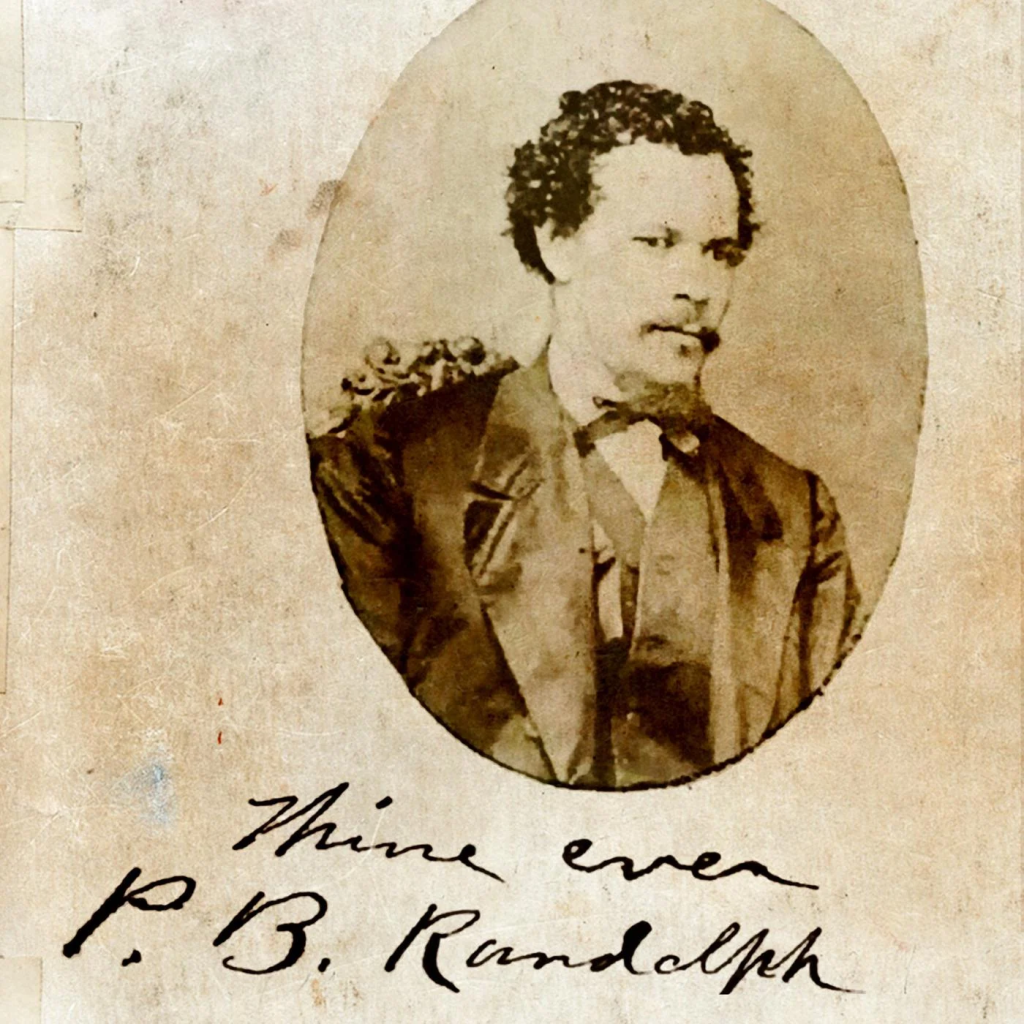
Photography and Signature of Paschal Beverly Randolph.
In summary, what appears clear from the research of Van Baden (2022) within the Pansophers‘ archives of Hermetic Brotherhood of Luxor documents, as well as from Greer’s (2009) comparative analyses, is that The Kybalion is essentially a New Thought reformulation of the central principles that Atkinson drew from three 19th century texts that were studied by the Chicago HBoL: Kingsford and Maitland’s Virgin of the World of Hermes (1885), Burgoyne’s Celestial Dynamics (1896) and Huntley’s Harmonics of Evolution (1897). As an addendum, this author was informed both by Samuel Robinson and Teike Van Baden in 2024 that, from the way Atkinson writes, the version of Kingsford and Maitland’s ideas that ended up crystallizing into The Kybalion reflects, not the text directly, but the works as-interpreted by the Hermetic Brotherhood of Luxor. As per Van Baden (2022), who introduced his article as the first in a series, the Pansophers are planning additional forthcoming publications to further elucidate this point. Interested readers can follow the Pansophers’ website for upcoming updates.
To close this section with an amusing point on the Atkinson-Hermetic Brotherhood of Luxor connection, although the HBoL were known for their esoteric sexual energy and sex magic teachings influenced by Paschal Beverly Randolph, Atkinson did not appear pleased with how some members interpreted and applied these teachings. Indeed, in Chapter 2 of The Kybalion (1907), Atkinson warns against ”the many base, pernicious and degrading lustful theories, teachings and practices, which are taught under fanciful titles, and which are a prostitution of the great natural Principle of Gender” (Atkinson and Deslippe, 2011). Although The Kybalion came out 7 years after the Victorian Period ended in 1901, its version of “Hermeticism” would have been very much at home in the period’s infamous prudishness.

First Edition of The Kybalion: Hermetic Philosophy by ”Three Initiates” (1908).
I. The Lone Initiate: Concluding Reflections on the Authorship of The Kybalion
In conclusion, despite the generally theoretical and not practically-oriented nature of the text, the limited nature of its actual Hermetic content, and its spurious origins, The Kybalion (1908) remains an important text in the history of 20th century occultism and the New Thought movement. In this article, we have presented a critical-historical analysis of 12 proposed candidates for members of “The Three Initiates.” As a result of this analysis, we conclude that The Kybalion (1908) was likely the sole work of William Walker Atkinson, with the pseudonym of the “The Three Initiates” having been chosen as a reference to the Thrice-Great Hermes Trismegistus, legendary father of the Hermetic Tradition. While it is possible that Paul Foster Case may have helped edit or discuss ideas with Atkinson, this seems unlikely for the reasons we have presented. The research presented in this article suggests that Atkinson wrote The Kybalion as an attempt to provide a New Thought formulation of Hermetic ideas he drew from his three sources, Kingsford and Maitland’s Virgin of the World of Hermes (1885), Burgoyne’s Celestial Dynamics (1896) and Huntley’s Harmonics of Evolution (1897).
As a final note to close out the present study, Atkinson’s preoccupation with crystalizing and clarifying the “Universal Laws” that govern the spiritual and material worlds according to his understanding of the Principle of Correspondence (“As Above, So Below”) would continue throughout his life. Indeed, shortly before Atkinson suffered a significant stroke and passed away in 1932, he completed his definitive statement on what he took to be the universal laws of nature. This work represents the culmination of the ideas he first articulated in The Kybalion. Entitled The Seven Cosmic Laws and written in 1931 this fascinating work of the mature Atkinson is the final manuscript of William Walker Atkinson. For decades, it remained unpublished until Professor Deslippe received clearance from the Atkinson Estate to publish it in his The Kybalion: The Definitive Edition (2011). Readers with an interest in The Kybalion and New Thought history and how its author understood the cosmic principles he strove to articulate in the original 1908 text would be highly recommended to pick up this work. The 2011 text not only features a fantastic scholarly introduction and definitive text of The Kybalion, but also the complete text of The Seven Cosmic Laws.
In closing, while this author’s esoteric studies ultimately carried him far from The Kybalion since his first time flipping through its mysterious pages as an adolescent, he continues to look fondly on the wide-eyed moments he first spent poring over the cryptic statements of Universal Laws that he first found in this 1908 text. He remains grateful to Atkinson’s text for helping to spark the hunger for the Light of the Hidden Knowledge that would go on to carry this fellow Initiate through the rest of his spiritual and authorial life.
References
Atkinson, W. W., & Deslippe, P. (2011). The Kybalion: The Definitive Edition. New York : Jeremy P. Tarcher/Penguin Books.
Atkinson, W. W. (2016). The Secret Of Mental Magic. Denmark: Jazzybee Verlag Publishing.
Bailey, R. (2009). The Confession of Cyprian of Antioch: Introduction, Text, and Translation. Montreal: McGill University Press.
Bailey, R. (2017). The Acts of Saint Cyprian of Antioch: Critical Editions, Translations, and Commentary. Montreal: McGill University Press.
Block, S. (2021). “On Gender in Hermeticism: Excerpts and Commentary.” The Digital Ambler. Retrieved on February 21, 2022. https://digitalambler.com/2021/03/11/on-gender-in-hermeticism-excerpts-and-citations/
Block, S. (2021). “On Gender in Hermeticism: Analysis, Ranting, and Questions.” The Digital Ambler. Retrieved on February 21, 2022. https://digitalambler.com/2021/03/12/on-gender-in-hermeticism-analysis-and-ranting/
Block, S. (2019). “The Kybalion is Still Crap No Matter Who You Think You Are.” The Digital Ambler. Retrieved on February 21, 2022. https://digitalambler.com/2019/03/08/the-kybalion-is-still-crap-no-matter-who-you-think-you-are/
Bull, C. H. (2015). Ancient Hermetism and Esotericism. Aries, 15(1), 109-135.
Bragdon, C. F. (1910). Episodes from an Unwritten History. Rochester, New York: The Manas Press.
Bragdon, C. F. (1938). More Lives Than One: Autobiography of Claude Bragdon. New York: Alfred A. Knopf.
Bragdon, C. (1901). The Bodily Temple. House and Garden (May): 192–196.
Bragdon, C. (January, 1908). “The Gothic Spirit.” Christian Art. Vol. 2, No. 4. Retrieved March 30, 2022.
Charvet, D. (2007). Alexander: The Man Who Knows. Pasadena, CA: Mike Caveney’s Magic Words Press.
Collins, M. (1889). The Blossom and the Fruit: A True Story of a Black Magician. Retrieved on February 18, 2022. https://archive.org/details/blossomandfruit01collgoog
Collins, M. (1914). The Crucible. London: The Theosophical Publishing Society.
Commercial and Financial Chronicle. (October 19, 1907). New York.
Copenhaver, B.P. (1993). Hermetica: The Greek Corpus Hermeticum and the Latin Asclepius in a New English Translation, with Notes and Introduction. Cambridge: Cambridge University Press.
Chapel, N. E. (2013). “The Kybalion’s New Clothes: An Early 20th Century Text’s Dubious Association with Hermeticism.” Journal of the Western Mystery Tradition. No. 24, Vol. 3. Vernall Equinox. Retrieved February 21, 2022. http://www.jwmt.org/v3n24/chapel.html
Clark, P. (2013). Paul Foster Case: His Life and Works. New Zealand: Ohm Publishing.
“Dee, J.” (2010). Tuba Veneris or The Consecrated Little Book of Black Venus. Translated from Latin by Teresa Burns and Nancy Turner. In Journal of the Western Mystery Tradition 12(2). Available at: http://www.jwmt.org/v2n12/venus.html %5BAccessed 4 June 2018].
Demarest, M. (2017). “JUL 25 Chain Gang and Bucket Shop: A Note on Albert Sidney Raleigh and George W. Wiggs.” Chasing Emma: Resolving the contradictions of, and filling in the gaps in, the life, work and world of Emma Hardinge Britten.
Denlinger, D. (1997). Correspondence on the Authorship of The Kybalion. Archived by Levity. Accessed February 16, 2022. http://www.levity.com/alchemy/t_kybal.html
Dresser, W. D. (1919). A History of the New Thought Movement . New York: Thomas Y. Crowell Company.
Ellis, E. V. (1994). Geomantic Mathematical (re) Creation: Magic Squares and Claude Bragdon’s Theosophic Architecture. Design–Build, 4th. Accessed March 30, 2022 from https://www.researchgate.net/profile/Eugenia-Ellis/publication/285603189_Geomantic_ReCreation_Magic_Squares_and_Claude_Bragdon%27s_Theosophic_Architecture/links/5ff4c87b92851c13feefc49f/Geomantic-ReCreation-Magic-Squares-and-Claude-Bragdons-Theosophic-Architecture.pdf
Erik, R. (2016). “The Nature of God in the Kybalion and the Hermetica.” Arnemancy. Retrieved February 21, 22.
Farnell, M. (2003). The Many Lives of Mabel Collins. Theosophical History Conference 2003.
Farrell, N. (2014). “Why the Kybalion Should Not Be Taken Seriously.” NickFarrell.IT Accessed January 20, 2024 from https://www.nickfarrell.it/kybalion/
Forum Borealis (2018). “Philip Deslippe – Kybalion Unmasked: 3 Initiates and 7 Cosmic Laws.” Accessed February 21, 2022 from https://open.spotify.com/episode/4m0Zdm6kELw9WtUKtDMTkr
Forzoni, R. (2016). “Alexander: The Man Who Knows.” Published in The Magic Circular. Accessed May 1st, 2022 from https://forzonimagic.com/mindreaders-history-forzoni-magic-london-mindreader-london-magician/alexander-man-knows/
Garrett, R. (2012). “Hermetic Brotherhood of Light, the Hermetic Brotherhood of Luxor, the OTO and Chicago.” Occult Chicago. Accessed February 6, 2024 from https://occultchicago.blogspot.com/2012/11/hermetic-brotherhood-of-light-hermetic.html
Gewurz, E. (1916, September). Comments on “Light on the Path.” The Messenger. Accessed February 16, 2022. https://www.theosophical.org/files/resources/articles/LightonthePath.pdf
Godwin, J. (1995). The Hermetic Brotherhood of Luxor: Initiatic and Historical Documents of an Order of Practical Occultism. York Beach, Maine: Weiser Books.
Ghosh, A., & Ghosh, A. (2020). Chronology of Vedic and Vedānga Periods. Descriptive Archaeoastronomy and Ancient Indian Chronology, 109-137.
Greer, M. K. (2009). Source of The Kybalion in Anna Kingsford’s Hermetic System. Accessed February 17, 2022. https://marykgreer.com/2009/10/08/source-of-the-kybalion-in-anna-kingsford%E2%80%99s-hermetic-system/
IAPSOP. (2011). The International Association for the Preservation of Spiritualist and Occult Periodicals. Accessed January 31, 2024 from http://iapsop.com/lessons/
Kunkin, A. (1997). Correspondence on the Authorship of The Kybalion. Archived by Levity. Accessed February 16, 2022. http://www.levity.com/alchemy/t_kybal.html
Levitt, S. H. (2003). The dating of the Indian tradition. Anthropos, 341-359.
Lopez, C. (2020). The Veda. In Routledge Handbook of South Asian Religions (pp. 17-48). Routledge.
Mead, G.R.H. (2015). Corpus Hermeticum – Translated. New York: Scholar’s Choice.
Master Mind Magazine. (1915, March). Annie Rix Milix (Ed.). Retrieved February 6, 2024 from http://iapsop.com/archive/materials/master_mind/master_mind_v7_n6_mar_1915.pdf
Membership Ledger Cards Roll 3, number 01994. Theosophical Society in America Archives.
Nelson Marquis, A. (Ed.). Who’s Who in America, 1912 – 1913, Vol. VII [7]: A Biographical Dictionary Of Notable Living Men And Women In The United States. New York: N. Marquis & Company
Nichols, K. (2013). “Mysteries of the Hermetic Brotherhood of Luxor.” Newtopia Magazine. Accessed January 19, 2024 from https://newtopiamagazine.wordpress.com/2013/08/15/mysteries-of-the-hermetic-brotherhood-of-luxor/
Odell, K. A., & Weidenmier, M. D. (2004). Real shock, monetary aftershock: The 1906 San Francisco earthquake and the panic of 1907. The Journal of Economic History, 64(4), 1002-1027.
Pearson, A. (2018). “The Bells and Trumpets of Solomon: Resounding Instruments of the Solomonic Grimoires.” Light in Extension. Accessed February 16, 2022.https://lightinextension.wordpress.com/2018/06/05/the-bells-and-trumpets-of-solomon-resounding-instruments-of-the-solomonic-grimoires/
Peterson, J. H. (2005). The Sixth and Seventh Books of Moses. Esoteric Archives. Accessed August 15, 2018 from http://www.esotericarchives.com/solomon/ksol2.htm
Peterson, J. H. (2018). The Key of Solomon the King. Esoteric Archives. Accessed August 15, 2018 from http://www.esotericarchives.com/solomon/ksol2.htm
Richardson, A. (2007). Priestess: The Life, and Magic or Dion Fortune – New and Revised Edition. Loughborough, UK: Thoth Publications.
Robinson, S. (2019). “Beverly Randolph and the Forgotten Euleusinian Rosicrucians of England.” Pansophers. Accessed January 19, 2024 from https://pansophers.com/paschal-beverly-randolph-rosicrucian/
Sahagun, Louis (2008). Master of the Mysteries: The Life of Manly Palmer Hall. Port Townsend, Washington: Process Media.
Skinner, S. (2013). Magical Techniques and Implements Present in Graeco-Egyptian Magical Papyri, Byzantine Greek Solomonic Manuscripts and European Grimoires: Transmission, Continuity and Commonality (The Technology of Solomonic Magic). Newcastle, Australia: University of Newcastle.
Smoley, R. (2011). ”The Mysterious Kybalion.” New Dawn 124. Accessed January 19, 2024 from https://www.newdawnmagazine.com/articles/the-mysterious-kybalion
Stratton-Kent, J. (2014). The Testament of Cyprian the Mage. Ludlow, UK: Scarlet Imprint.
Taylor, K. (2018). Claude Fayette Taylor: Senior Thesis. Accessed March 30, 2022 from https://theosophyart.org/2018/03/30/claude-fayette-bragdon/
Theosophical Society General Membership Register (TSGMR), 1875-1942. Accessed January 31, 2024 at http://tsmembers.org/. See book 1, entries 3051 and 3052 (website file: 1B/6).
Тошов, Х. И. (2021). “Formation and Development of the Ideas of Hermeticism.” Исследование Ренессанса Центральной Азии, 2(1).
Trismegistus, H. (2003). The Emerald Tablet. The Alchemy Reader: From Hermes Trismegistus to Isaac Newton, 27-28. Cambridge: Cambridge University Press.
U.S. Bureau of the Census (1975). Historical Statistics of the United States from Colonial Times to 1970. Published by the U.S. Department of Commerce. Accessed February 16, 2022. https://www.census.gov/history/pdf/histstats-colonial-1970.pdf
“The Magician’s Apprentice – Interview With An Occult Student of Dr. Joe Lisiewski.” (2021, November 7). Way of Fools Broadcast 25. Retrieved April 21, 2022 from https://www.youtube.com/watch?v=HPLxr76cWgo
Wood, R. (1997). Correspondence on the Authorship of The Kybalion Between Dan Denlinger and Robert Wood. Archived by Levity. Accessed February 16, 2022. http://www.levity.com/alchemy/t_kybal.html
Van Beiden, T. (2022). The Kybalion and its Hermetic Brotherhood of Luxor Origins.” Pansophers. Accessed February 21, 2022. https://pansophers.com/kybalion-hermetic-brotherhood-of-luxor-origins/
Zalewski, P. (1996). Correspondence on the Authorship of The Kybalion. Archived by Levity. Accessed February 16, 2022. http://www.levity.com/alchemy/t_kybal.html































